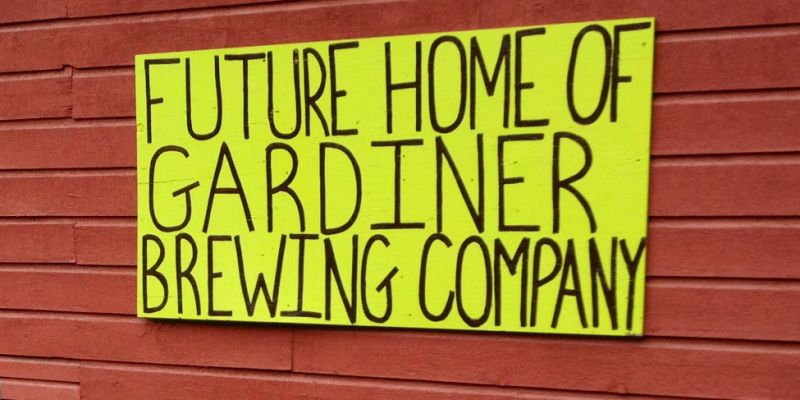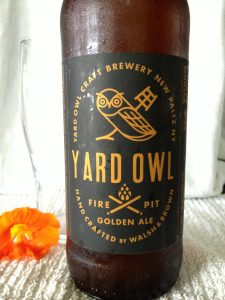
“You can’t be a real country unless you have a beer and an airline – it helps if you have some kind of a football team, or some nuclear weapons, but at the very least you need a beer.” — Frank Zappa
Visitors to the Cupcake Festival in May were excited to see the hand lettered notice shown in the image at left on the back of a barn on the Wright’s Farm property, and when I visited Yard Owl Craft Brewery recently, the two partners, Kristop Brown and James Walsh, were busy bottling and packing cases of Farm House Ale, the most popular of the three beers they are now producing in Gardiner. Clearly Gardiner now qualifies, according to Frank Zappa, as a real town.
James and Kristop of Yard Owl Brewery met originally in New Jersey and found they had compatible backgrounds for their new venture. James and his wife, Michelle, own the Mudd Puddle in New Paltz. Kristop is the winemaker at Robibero Family Vineyards and Glorie Farm Winery. They decided to combine forces and open Gardiner’s first brewery.
It took about two years to complete all the steps required to open. Among other things, their brewery had to pass New York State Agriculture and Markets inspection and various state permits had to be obtained, along with federal approval of their labels.
James said, “I had roughed out a label but then we got Jeremy Dawkins to design our label, which is striking. But it took us three attempts to get federal label approval. It had to do with the wording and placement of required information on the label.”
I asked James about the origin of the name. “We live in the woods with lots of owls around . . . barred owls, so it just struck me,” he said.
 For now, Yard Owl is bottling only in 22 ounce bottles at their brewery on Albany Post Road, but has plans for casks and kegs next. Their offerings are:
For now, Yard Owl is bottling only in 22 ounce bottles at their brewery on Albany Post Road, but has plans for casks and kegs next. Their offerings are:
Dubbel Ringer Ale, a ruby hued Belgian style ale, brewed with Belgian hops and sugars. 7.5% alcohol by volume.
Farm House Ale, brewed with hops from Alsace and a touch of wheat. A rustic table beer with a spicy aroma and a full body. 6.5% alcohol by volume.
Fire Pit Golden Ale, a cold conditioned golden ale with a crisp noble hop aroma and clean finish. 6% alcohol by volume.
Kristop is particularly adept at blending ingredients for the desired result; he has been a winemaker for ten years, and a couple of years ago, James spent time in the brewing program at the University of California, Davis, and went back last May for additional courses.
Yard Owl’s products are featured locally at Bacchus, Jar’d Wine Pub and Rock & Rye, all in New Paltz, and the Mountain Brauhaus in Gardiner. The beer is also retailed by K & E Discount Beverages in New Paltz.
James and Kristop continue to perfect their products but longer range they envision perhaps a rustic barn at their brewery with an attached tasting room. 
Colin Boylan, below, left, is the fifth generation of the Wright family to own and work at Wright’s Farm in Gardiner, founded in 1904. He and his sister, Samantha, are the partners behind Gardiner Brewing. Colin elaborated, “I made less than great beers in Vermont but the process was still fun and made me want to keep doing it and learn how to make better beer.
“We plan to use local ingredients, not just from my family’s farm, but from whoever is local and has good stuff. The idea is to craft high quality beers that showcase quality ingredients. Think of the chef who serves tomato slices with just a pinch of salt and basil. Simple, high quality and fresh.”
To that end, Gardiner Brewing is already growing 220 hop plants harvestable this year and another 400 that can be harvested in three years.
Every beer contains four basic ingredients: malt, water, yeast and hops. The differences in beer tastes depend on how these four ingredients are prepared, how and when they are combined plus whatever else the brewer chooses to add to achieve a particular body and taste. Barley is the usual grain ingredient of beer but before it can be used to make beer it has to be malted. This can take a week or more, and requires carefully sprouting and drying the grain seeds before the sprout is too large. There is a need for both precision and “feel.”
Colin says, “We have grains that grow in New York State, but malt houses that are out of state. I’m trying to figure out if we can get someone to start a malt house in the area. I know there’s some interest over in Orange County. But the only malt house I know of in New York State was started about a month ago in the Finger Lakes region. They tend to be in Pennsylvania or New England.”
Right now, Colin is retrofitting the barn and exploring the licensing process which can take six months to longer than a year. But Colin is hopeful he’ll have a license in a year and can be selling beer three months after that —probably only in growlers initially.
Colin doesn’t simply want to imitate a beer he likes. He explained, “I want to use what I have available and if it’s not available, figure out how to grow it and see what we can make. To me a local beer should be made out of something in the region. Try to do what you can with what you have where you are. Some people tend to sacrifice quality for local. I don’t think you can do that. We want to make high quality beer out of what can grow in this area.” Once in production, they plan to work in small batches while learning the ingredients. “We want to get it right before we get any bigger.”
